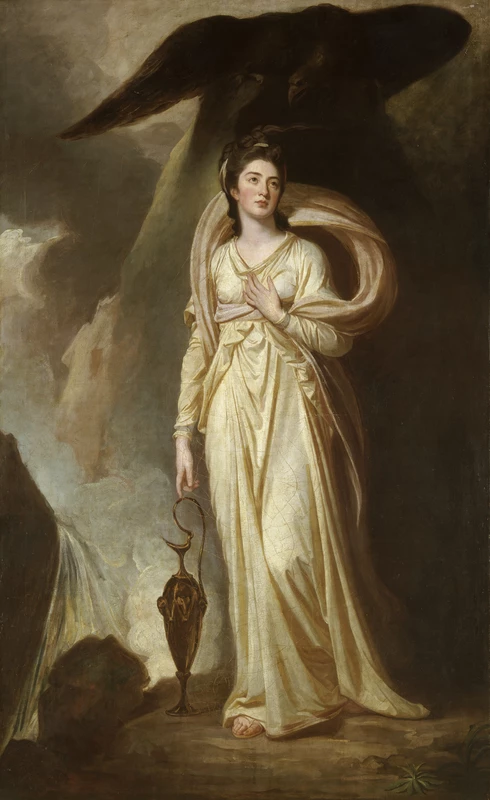Grand portrait for a wedding in 1777
Amgueddfa Cymru has an outstanding group of whole-length portraits from the 1770s. These include a work that was critical in establishing the reputation of the artist George Romney after his return from a career-making visit to Italy, and helped to make him the chief competitor of Reynolds and Gainsborough.
George Romney (1734-1802), Elizabeth Harriet Warren (Viscountess Bulkeley) as Hebe, c. 1776 Oil on canvas, 238.5 cm x 148 cm.
Romney had moved to London from Kendal in 1762 to seek success and fame. One of the pictures that began to make his reputation was a grand group portrait of the Warren family of Poyton, Cheshire, completed in 1769.
Between 1773 and 1775 Romney travelled in Italy, to study classical and renaissance art first-hand and to increase his credibility with patrons. On his return to London he found himself largely forgotten. However, he leased a large house in Cavendish Square, and some of his former supporters came forward with new commissions.
Sir George Warren was one of the first, ordering a portrait of his daughter Elizabeth, to mark her wedding in April 1777 to Thomas, 7th Viscount Bulkeley of Beaumaris (1752-1822). The principal landowner in Anglesey, and an associate of Sir Watkin Williams-Wynn, he was MP for his county from 1774 to 1784, when he was made a British peer.
She sat for Romney on five occasions during May 1776. The artist then fell ill, and the final sitting took place in December. He put much thought into the composition, and there are sketches for it in several collections.
Ronmey had long wanted to establish himself as a painter of "histories" (works with a literary and moral message), and Elizabeth is depicted as Hebe, cupbearer of the gods and goddess of youthful beauty. Hebe's traditional attributes are a cup or ewer and the eagle, symbolic of her father Zeus. She was a popular allegorical persona for 18th-century portraits of young women.
This work exemplifies the "sublime and terrible" aspect of Romney's style. The mountain cascade is in austere, almost monochrome colour. The picture was intended to remind the viewer of classical sculpture. It was one of a number of neo-classical works that transformed his standing in 1776 and led to twenty years as London's busiest and most fashionable portrait-painter.
Elizabeth and Thomas Bulkeley had no children and her portrait, which hung in the drawing room of their Anglesey house, Baron Hill, was eventually inherited by his half-brother. It passed to the Williams-Bulkeley family until bought by the Museum (where it had been on loan since 1948) with the assistance of the Art Fund in 2000.
Further reading:
Fritz Saxl & Rudolph Wittkower, British Art and the Mediterranean , Oxford 1948, repr.63(4);
John Steegman, A Survey of Portraits in Welsh Houses, vol. 1, Houses in North Wales, National Museum of Wales, Cardiff 1957, p.25;
David Irwin, English Neoclassical Art, London 1966, p.152.
